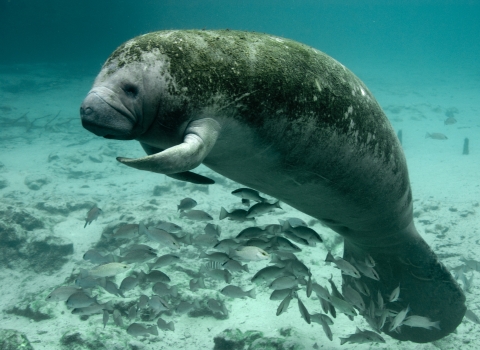NAVAL BASE CORONADO, Calif. – On Friday, the U.S. Fish and Wildlife Service (Service) and U.S. Navy finalized a Conservation Candidate Agreement for the continued protection of five recently delisted species endemic to the military-owned San Clemente Island.
Decades of collaborative conservation led to the recovery of the San Clemente Island paintbrush, lotus, larkspur and bush-mallow plants and San Clemente Bell’s sparrow, and their removal from the federal lists of threatened and endangered species in 2023. Although the species no longer require Endangered Species Act protection, they remain potentially vulnerable to habitat changes and will benefit from post-delisting monitoring and management actions.
“This agreement represents a commitment to continuing our decades-long partnership, and we are grateful for the Navy’s dedication to helping protect Southern California’s habitats and the species that depend on them,” said Scott Sobiech, Carlsbad Fish and Wildlife Office field supervisor.
The agreement signed today outlines measures that support the Navy’s need to meet new training requirements while also sustaining recovery of the species. Areas of particular importance to each species will be identified to minimize human caused impacts and maintain the biological and ecological integrity of their habitats.
“The Navy is proud to have shared more than 40 years of collaboration with the U.S. Fish and Wildlife Service to improve the habitat for these species,” said CAPT Ladislao Montero, Commander, Naval Base Coronado. “This announcement is a milestone in our efforts and should be celebrated. The Navy remains committed to our conservation efforts on San Clemente Island and to being good stewards of the seas and habitats so critical to our national security.”
Candidate Conservation Agreements are voluntarily entered into between the Service and other Federal or State agencies, local governments, Tribes, businesses, organizations, or non-Federal citizens to prevent the future need to list or re-list species. This agreement will remain in effect for 20 years with an annual review of any new information pertaining to the species’ status.
San Clemente Island is one of eight islands that comprise the Channel Islands off the coast of Southern California. The delisting of four plants and one bird adds to the list of species that have now successfully recovered across the islands, including the island night lizard, island fox, and the Santa Cruz Island dudleya and island bedstraw. Bald eagle and peregrine falcon populations decimated by impacts from DDT have also rebounded nationally and are successfully breeding on the Channel Islands. Photos of San Clemente Island species are available here.



